Schweinshaxe recipe for the quintessential dish of the Bavarian beer halls. Learn to make a fork tender and juicy roasted pork hock (knuckle) with crispy skin.
Go straight to the Recipe Card or
Read on for relevant information and step-by-step pictures (2 mins)
What is Schweinshaxe (German Pork Hock)?
Schweinshaxe – roasted, skin-on pork hock (knuckle) is a veritable symbol of Bavarian cuisine and beer culture. You will find a crispy and tender German pork knuckle on the menus of beer halls, beer gardens, restaurants big and small and even street food stalls all over Bavaria and other parts of the country.
The traditional way to roast pork hock is on a spit. The knuckles are skewered on long metal rotisserie rods and and set up in front of a heating element.
One of the most spectacular displays of roasting pork knuckles we have come across is at Haxnbauer in Munich, Germany. If you visit the city during Oktoberfest, the Haxenbraterei near the Hofbräu tent on the Wiesn is a great place to enjoy Schweinshaxe. Every year more than 80,000 pork hocks are consumed on the Oktoberfest grounds alone.
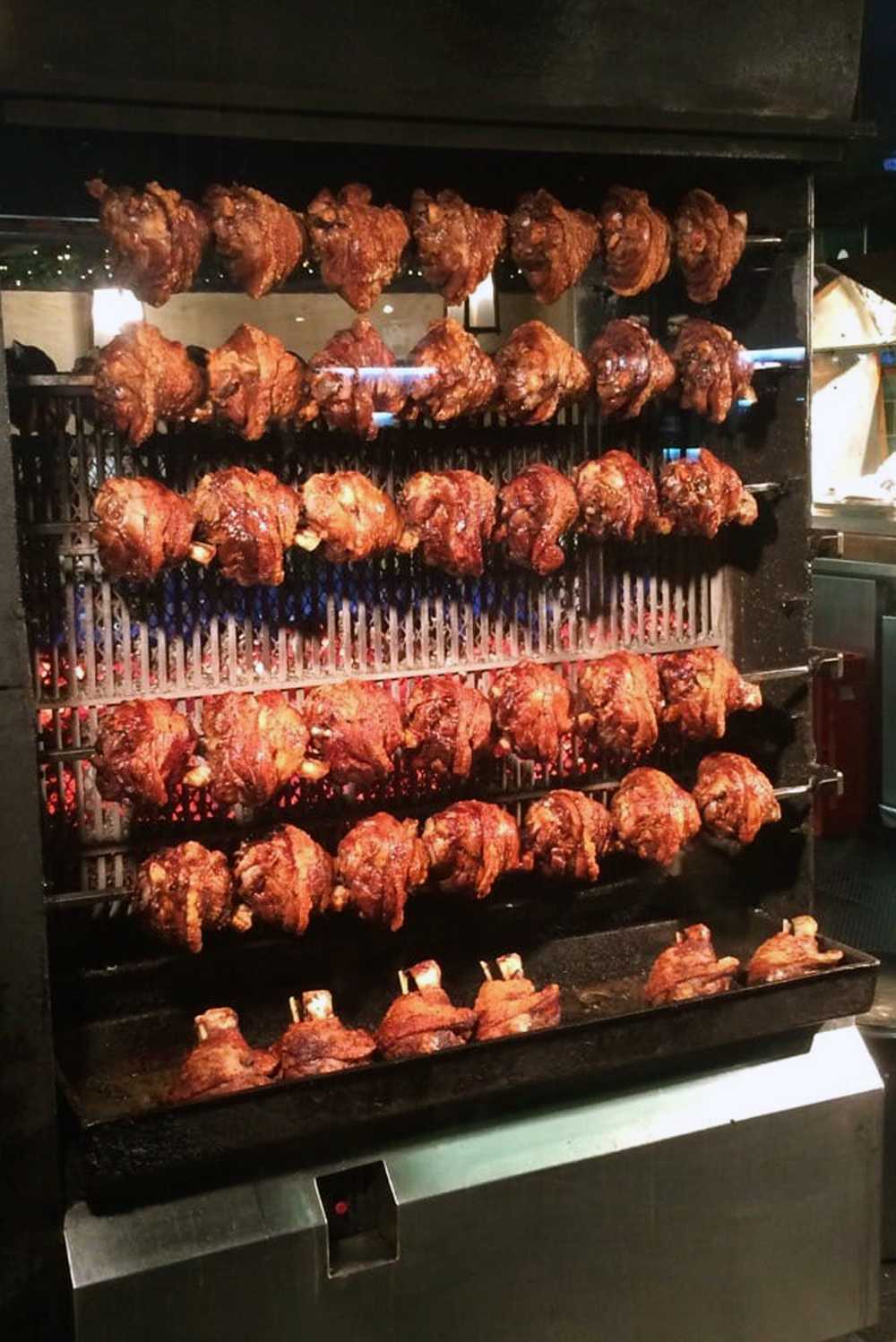
Pork hocks roasting at Haxnbauer in Munich. Each Schweinshaxe is weighed when ready to be served and the price charged to patrons is calculated based on the weight.
IMPORTANT NOTE: In the US the words pork knuckle, pork hock and pork shank are used interchangeably to reference the general area of the pig’s leg where the foot connects with the shoulder or hip of the animal (depending on front or back feet).
Technically, shanks have more meat (especially hind shanks) because they come from the area closer to the shoulder or hip parts of the pig, while hocks are a bit bonier as they constitute the lower portion of the cut, closest to the foot.
The reason the word knuckle comes into play is because it is a direct translation from German – Schwein=pig, haxe=knuckle and subsequently Schweinshaxe=pork knuckle. Overall, whether you say pork hock, pork shank or pork knuckle you will be referencing the same thing.
Ingredients You Need to Make German Pork Hock at Home
- Pork hock(s). Preferably from the rear ankle, with the rind on. Average weight is around 2 lbs per ham hock.
- German seasonings. Bay leaf, caraway seed and cloves for the poaching liquid, if using (see step-by-step below). Caraway seed, black pepper and salt for the rub.
- Garlic. To add to the poaching liquid, if using.
- Onion. To add to the poaching liquid if using and more to slow roast with the pork hocks.
- Dark beer. To add to the pan drippings during slow roasting. Don’t skip if you want to make a delicious beer gravy to serve with the Schweinshaxe. Choose a dark German lager such as dunkel, bock, doppelbock or schwarzbier or an amber lager such as Marzen or Vienna lager.
Where to buy Schweinshaxe?
In Bavaria pork hocks are sold with the skin (rind) attached and during roasting it becomes nice and crispy. To find skin-on pork hocks in the US you must either go to the butcher and request them or buy them online.
We used to ask the local butcher for skin-on pork knuckles until we happened upon the choice offerings of D’Artagnan meat purveyors and are now devout fans of the cut they sell.
They offer porcelet hindshanks (affiliate link, if you purchase this product we may receive a small commission at no cost to you) imported from Canada that are just perfect for German style slow roasting. Once you order Schweinshaxe from D’Artagnan they are shipped promptly and are delivered to you perfectly packaged for the journey and still frozen.
Below are the last ones I pulled out of our freezer. We typically roast two hocks for four people.
How to Roast Schweinshaxe
You can approach roasting pork hocks in several different ways. The key to fall-off-the bone tender meat is to allow the collagen rich connective tissue abundant around the bones of pork knuckles to melt away and flavor the meat as it liquefies. Therefore lower temperatures work better.
If you happen to have a built-in or stand alone rotisserie oven you can approximate the pit roasting method without too much effort.
Here we assume that you will be using a regular oven. If your oven is fan assisted (convection oven) you should reduce the temperatures noted by about 35-40 F. To save a little bit of time you can poach the pork hocks prior to slow roasting them. It is up to you.
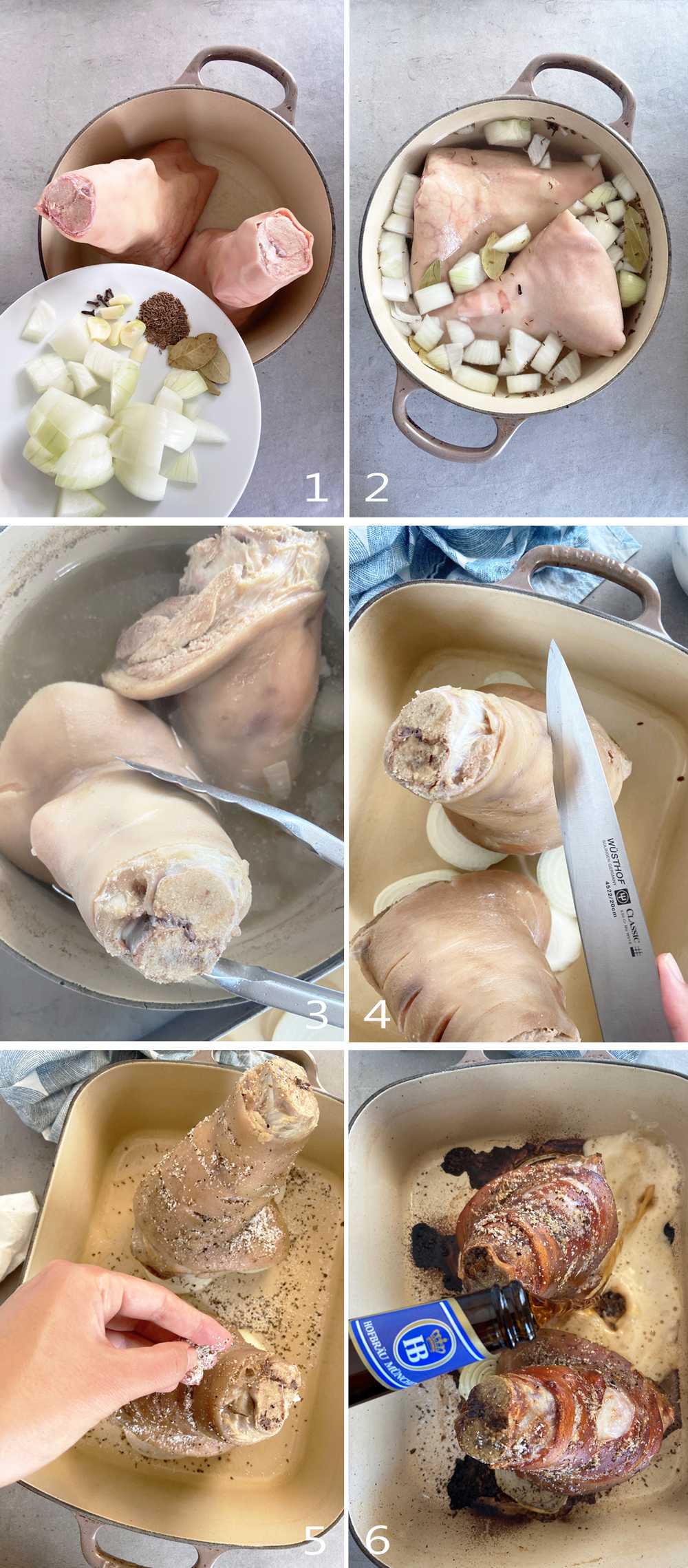
- Oven only.
- You will cook a large pork hock or two or more smaller ones at a lower temperature for a few hours, at least 3 hours and up to 4 1/2 hours (depending on the size, the calibration of your oven and if it is fan assisted or not).
- You will then finish off the cooking process either at a high temperature or by using the broil feature in order to crispen up the skin. Refer to the recipe card for precise steps.
- Poaching, then oven.
- You will begin by placing each pork hock in a deep pot along with a cooking liquid with chopped onion, garlic cloves and aromatics. You will then add enough boiling water to cover the pork hocks (#2 above) and let them poach over low heat (not simmer) for about an hour.
- Once you remove them from the poaching liquid you will score the skin with a sharp knife (#4), rub with spices (#5) and then slow roast on top of thick onion slices (or roasting rack).
- To make a delicious gravy you can add dark German beer to the roasting pan about half way through the cooking time (#6) and use the pan liquids after the Schweinshaxe is done.
How to Make The Schweinshaxe Skin Crispy and Use the Drippings for Gravy
Regardless of whether you poached prior to roasting follow these steps:
- Crispy skin. Towards the end of the slow roasting time remove the pig knuckles to a different pan and either increase the temperature of the oven to about 400 F or use the broiler element. The skin will get crispy and puff up. A crackling will form much faster in a convection oven, so watch them closely.
- Gravy (beer sauce). This is the moment when that dark German lager you added to the roasting pan really pays off! While the hocks are getting crispy in the pan you transferred them to, add about a cup of boiling water to the pan drippings, scrape all the brown bits and transfer the onions and pan liquids to a blender. Blend until smooth, then transfer to a small saucepan and bring to simmer. If you need to thicken the consistency, add a slurry (1 tbsp corn start mixed with 1 tbsp cold water) and stir it into the sauce. Keep warm until the Schweinshaxe is ready to serve.
Most Popular Sides for Schweinshaxe
Slow roasted Schweinshaxe is typically served with one of these sides, popular in Bavarian cuisine. A side of German mustard is a lovely touch as well.
- Dumplings. Potato dumplings (Kartoffelknödel, often stuffed with bread croutons) are by far the most common type of German dumpling dished up alongside Schweinshaxe. Pretzel dumplings and German Bread Dumplings are delicious here as well.
- Potatoes. Most frequently mashed potatoes, but warm German potato salad as well.
- Sauerkraut. No surprises here. Usually sauerkraut is not the only side, but rather a small helping is served alongside potatoes. It is more common with Eisbein.
- Rotkohl. Braised red cabbage with spices.
- Spatzle. Typically just browned in a bit of butter and sprinkled with herbs, but Kasespatzle as well.
If you would rather make Braised Pork Shanks like these below – here is a wonderful recipe for you!
Other Recipes You Might Enjoy
Braised Pork Shanks
Marzen Braised Lamb Shanks
German Beef Goulash
Sauerkraut Strudel
Oven Pork and Sauerkraut
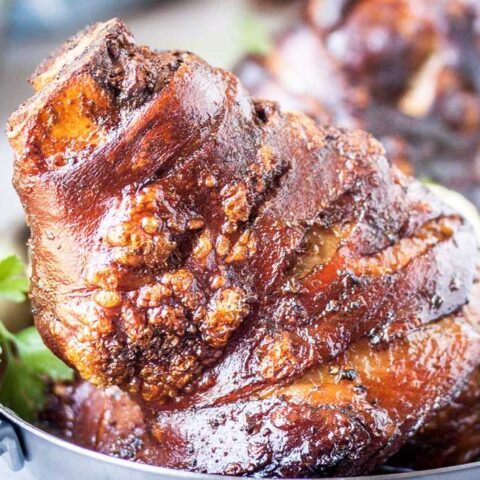
Schweinshaxe German Pork Hock (Roasted & Served with Dark Lager Gravy)
How to roast a pork hock like a Bavarian. Recreate Schweinshaxe, roasted German pork knuckle (aka pork hock or pork shank) with tender meat and crispy skin + make a delicious gravy from the pan drippings, flavored by dark German lager.
Ingredients
- 2 pork knuckles (aka hocks, about 1.5 lbs each, skin-on, uncured/unsmoked)
- 1 tbsp caraway seeds (plus 1 tsp extra if poaching)
- 2-3 bay leaves (needed only if poaching first)
- 4-5 whole cloves (needed only if poaching)
- 1 tsp black pepper
- 1 tbsp kosher salt
- 2-3 garlic cloves (needed only if poaching)
- 1 onion (plus 1 more if poaching)
- 12 oz dark German lager (dunkel, bock, schwarzbier or amber lager like Marzen or Vienna lager)
Instructions
OVEN ONLY METHOD
1. Preheat oven to 300 F.
2. Slice the onion into rings and place on the bottom of a roasting pan. Grind 1 tbsp caraway seeds (use pestle and mortar or spice grinder) and mix with ground pepper and salt.
3. Score the skin (rind) of each pork hock and rub with the spice mix from previous step. Place hocks on top of onions, with the tapered end facing up.
4. Slow roast for about 90 -120 minutes (depending on how large the hocks are, about 90 mins for 1.5 lbs hocks and about 120 for larger). Add the beer and a little bit of water to the pan and continue slow roasting for another 60-90 minutes. If the skin is browning too fast consider loosely tenting it with foil.
5. Transfer the hocks to another pan and keep the pan with the drippings and onions (see gravy below). Place the hocks back in the oven and either roast at 400 F or broil, until the skin gets crispy and puffy. Watch them closely during this step to avoid burning.
POACHING + OVEN METHOD
1. Bring 4 quarts of water to a boil. In a deep pot place the pork hocks, one chopped onion, garlic cloves, bay leaves, 1 tsp caraway and whole cloves. Add boiling water until the hocks are covered. Poach the hocks on low ( do not simmer) for about 60 minutes.
2. Preheat oven to 300 F. Cut an onion into thick rings and place at the bottom of a roasting pan. Remove the hocks from the poaching liquid and score the skin. Place the scored hocks on top of the onions, tapered end pointing up.
3. Grind 1 tbsp caraway seeds (use pestle and mortar or spice grinder) and mix with ground pepper and salt. Rub the mix over the hocks and place in the oven for 60 minutes.
4. Add the beer to the pan and continue slow roasting for another 60 minutes. If the skin is browning too fast consider tenting it with foil.
5. Transfer the knuckles to another pan and keep the pan with the drippings and onions (see gravy below). Place the hocks back in the oven and either roast at 400 F or broil, until the skin gets crispy and puffy. Watch them closely during this step to avoid burning.
GRAVY
Add 1 cup of hot water to the pan drippings and scrape the brown bits from the bottom. Transfer to a blender and blitz until smooth. Pour into sauce pan and bring to simmer. (If the consistency is too thin, add a slurry (1 tbsp corn starch mixed into 1 tbsp cold water) and whisk it in to thicken.)
Remove from heat and serve with the Schweinshaxe.
Notes
Roasting pork hocks is best done at low temperature (about 275-300 F) to allow for the collagen to melt. This will make the meat tender. The fat from underneath the skin of the hocks makes the meat juicy,
Exact times are tricky because the size/weight of each pork knuckle matters. The strength of your oven is also important - no two ovens are calibrated the same. Make adjustments to temperature if you notice that the skin is browning too fast, or loosely cover with tin foil.
Generally a 1.5 hock will need about 2 1/2 hrs of slow roasting plus a bit more at high temperature (400 F) or under broiler, as needed until the skin becomes crispy.
Because a pork hock can weigh up to 2 1/2 lbs adjustment to these times and temperatures should be made on an as needed basis.
If your oven is fan assisted (convection oven) you should reduce the temperatures noted by about 35-40 F.
Recommended Products
We are affiliates for Amazon and other vendors and qualifying purchases you make support our blog at no cost to you.
Nutrition Information:
Yield: 4 Serving Size: 1Amount Per Serving: Calories: 866Total Fat: 47gSaturated Fat: 17gTrans Fat: 0gUnsaturated Fat: 26gCholesterol: 299mgSodium: 1944mgCarbohydrates: 7gFiber: 1gSugar: 1gProtein: 91g

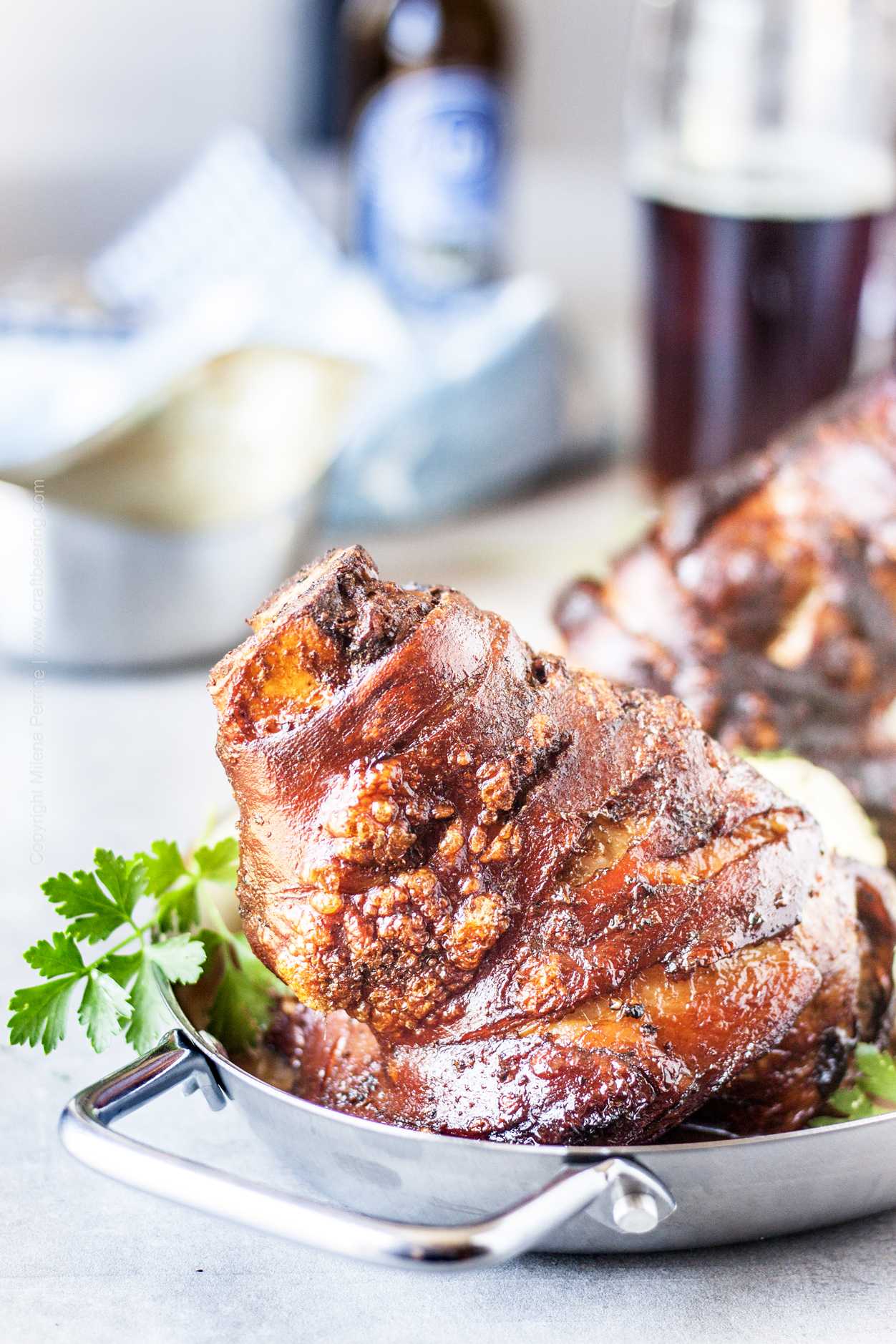
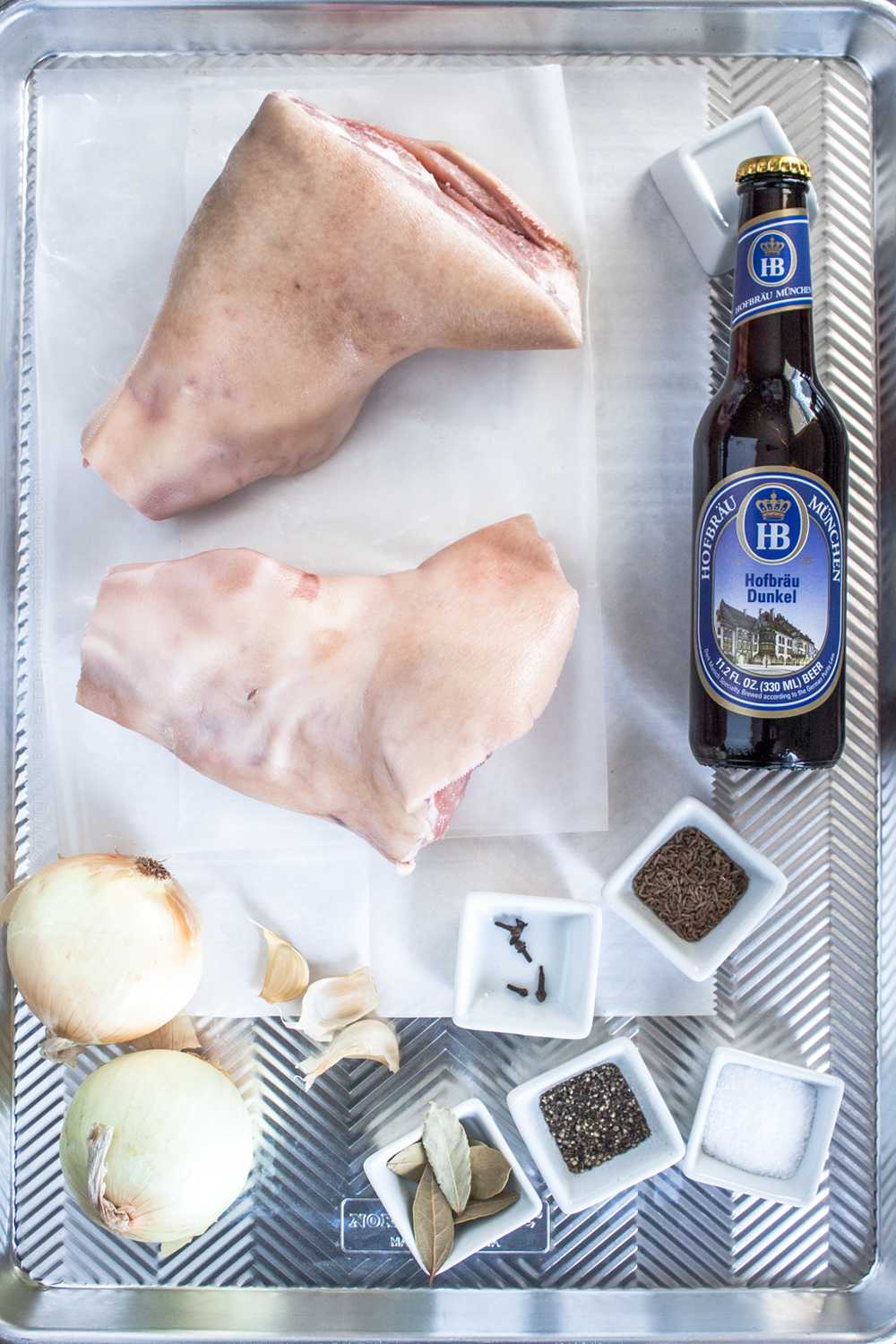
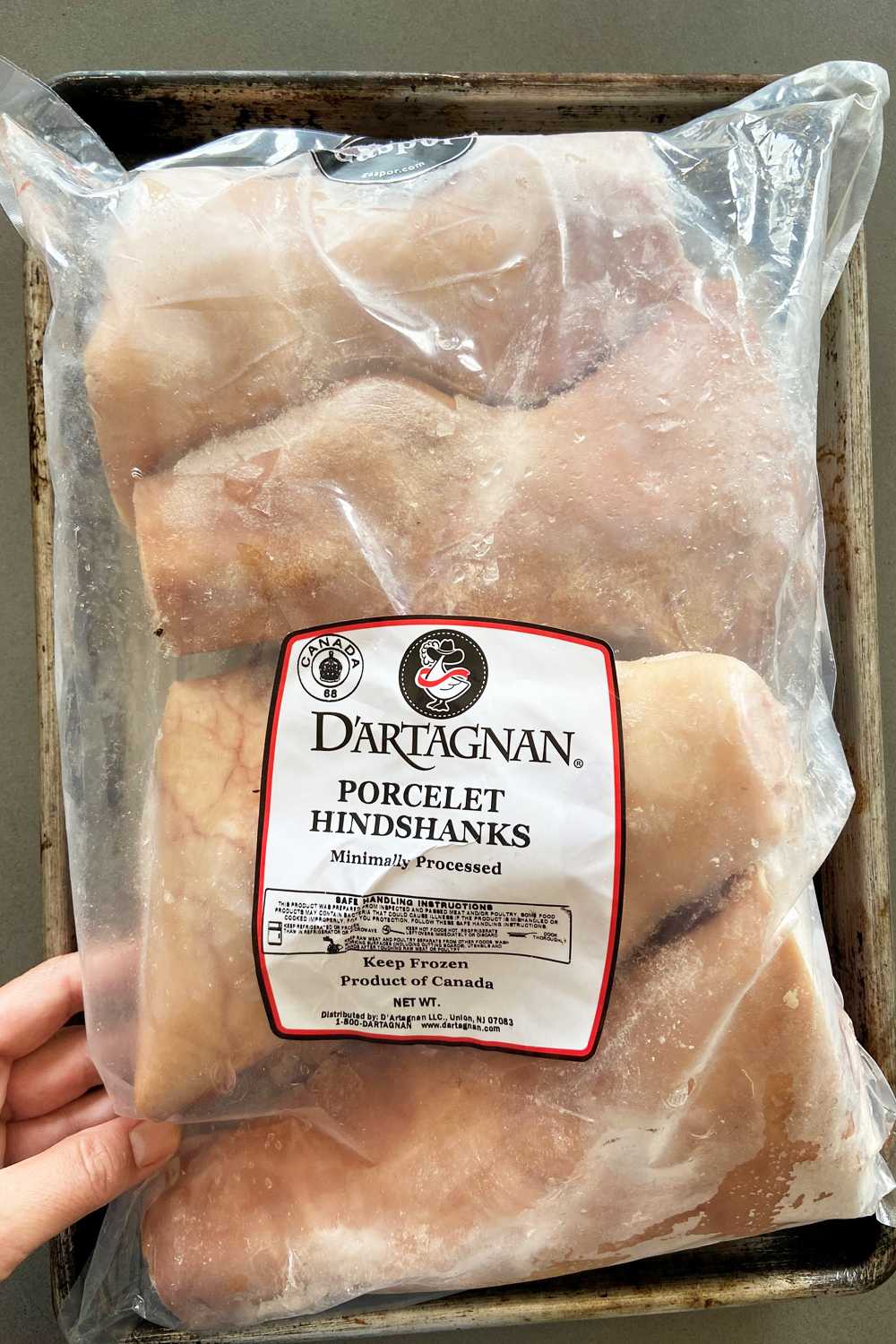
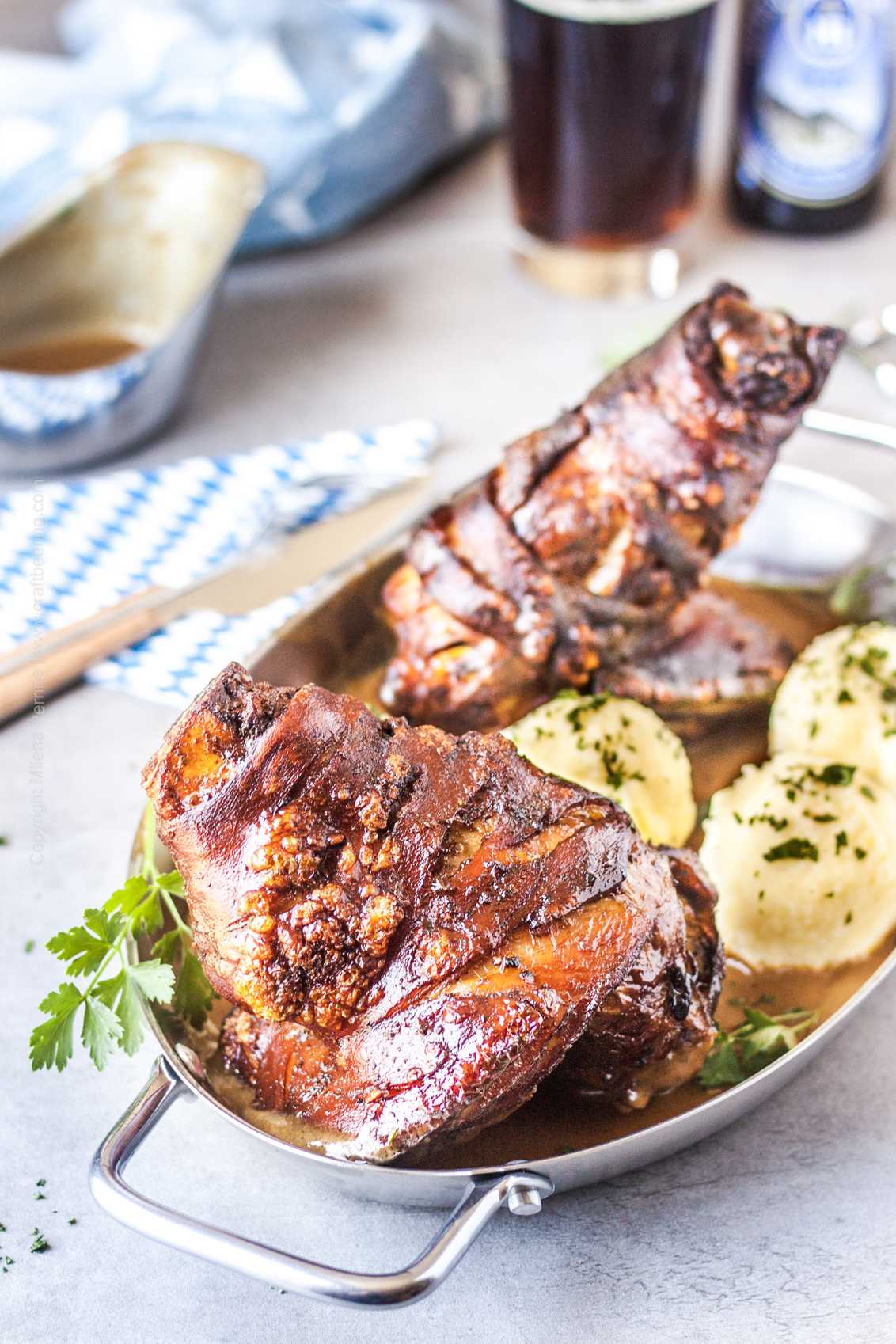
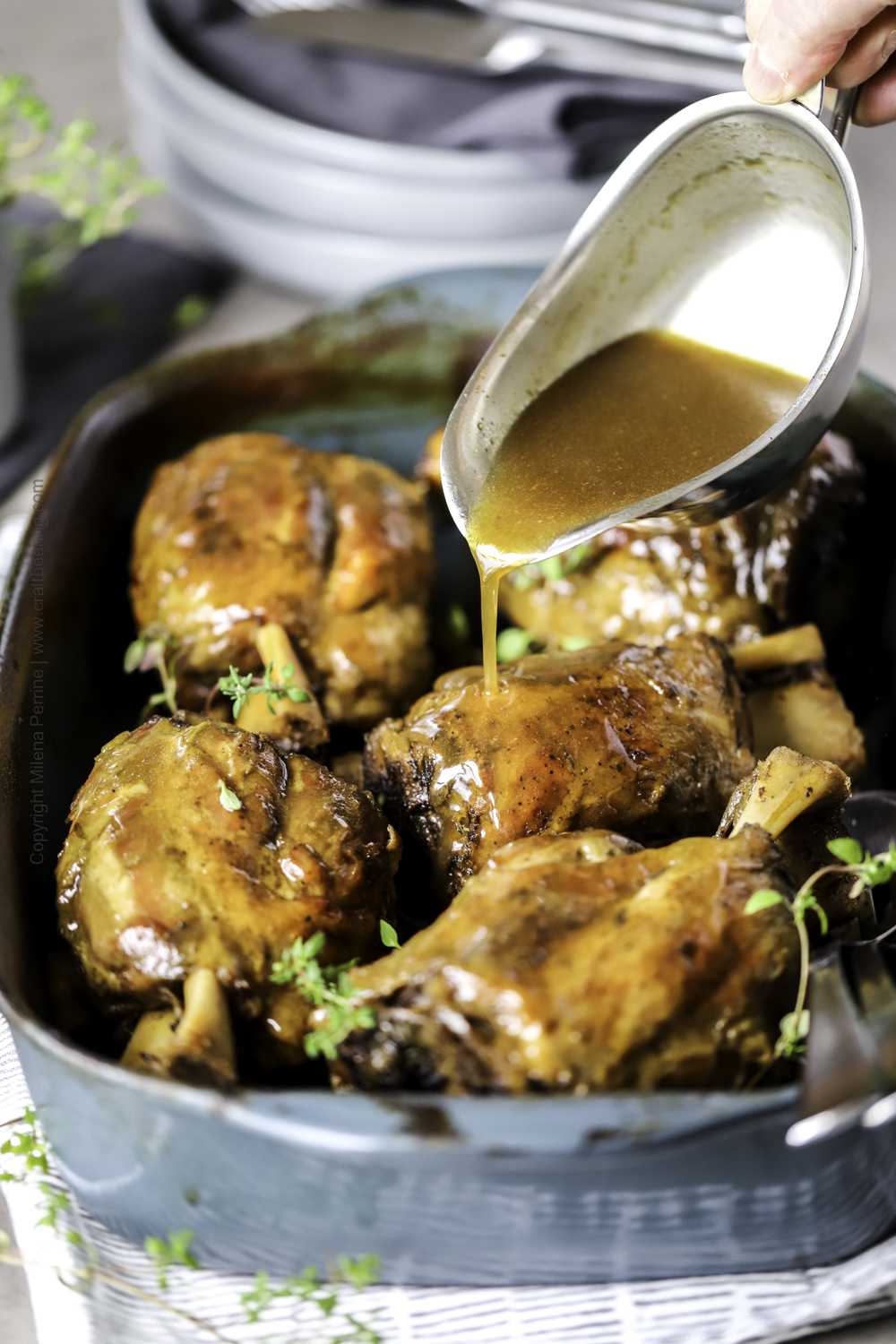
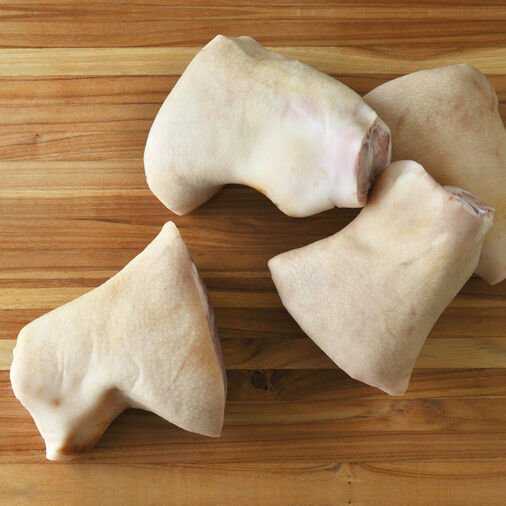
Stewart says
The only Weihenstephaner beer I can source is alcohol-free. Is that what you use?
Milena Perrine says
You can use the Weihensteaphaner. The best beer to use is a malty dark lager (in keeping with tradition). You can look for dunkel lager, bock or similar. If you find Schiner bock it will be perfect.
ashok says
Thanks for sharing this amazing recipe. My family loved it.
Wishfully German says
This recipe looks amazing, and I can’t wait to try it. Schweinshaxe is what I always order at German restaurants. I’m a little confused though as I look carefully at the wonderful information you provide. You say in the text beneath the numbered pictures that, “You will cook the pork hocks at a lower temperature for a few hours, at least 3 hours and up to 4 1/2 hours.” However, in the recipe card, the Oven Only instructions, and the Notes section, the minimum time is less than 3 hours and the maximum time does not get past three hours. Does the quoted text include significant time at high temp? Does the quoted text pertain to knuckles larger than 1.5 lbs? Any clarity you can provide is appreciated.
CraftBeering says
Thank you for your question – yes, it can take up to 4 1/2 hours as it says in the text, it really depends on the pork hocks – size, the breed of pig, how thick the skin is, their initial temperature (should bring them to room temp before you begin). It just takes a while at low temperatures, especially if around 275 F (and hocks simply cannot be rushed, you really need the collagen to liquify otherwise the meat will be tough). All that being said, you just cook them until done:) however long it takes. In the recipe it is really on the lower side of the time needed, very specific for the porcelet shanks shown, which are smallish, relatively tender (vs other ones we’ve bought in the past) and the skin is thinner. I wish a recipe could address all possibilities, but it is just a set of guidelines, it all depends on the actual hocks, your oven. But checking on them often will help you decide when to stop, also monitoring the skin is important at the end. Sometimes it can puff up and get to a crackling (when thicker especially) spontaneously without the need to broil. Thank you for bringing this to my attention, I will place a clarifying note in the recipe card about times.
Julie says
What do you typically do with the poaching liquid? It looks & smells too delicious to discard. Stock?
CraftBeering says
Julie, you can definitely simmer the poaching liquid for a just little while longer after you remove the shanks (to reduce it and concentrate the flavors) and then save it to use as stock for a future stew or a braise:)
Nehal Preet says
Woooohhhh…Superb recipe I am so in love with the texture. Thanks a lot for the yummy recipe. Regards.
Rada says
I love smoked pork hocks with the skin on. When I get the urge to eat some I cook mine in the pressure cooker for 35 to 40 minutes then I serve them with potatoe pancakes, sweet potatoes or baked potatoes, or sauerkraut. So delish. In fact I’ll be going to the Polish deli today to purchase some pork hocks. Can’t wait.
Dany says
Delicious!
Vic says
Thanks so much for answering. I’m planning to do this tomorrow for a twist on Easter Ham. Do you think i could do the 60 min simmer the day before?
Vic says
I assume the pork knuckles are raw and NOT smoked? Can you please confirm for me? Thx
CraftBeering says
Yes, absolutely – raw!
Of Goats and Greens says
Oh, this sounds very awesome! I am getting a couple of pork shanks/knuckles sometime towards the end of next month, from a meat share. A recipe like this will go very well! Thanks for sharing!
Marvellina|What To Cook Today says
Forget about pork chops! I haven’t eaten pork chops for probably years, but pork knuckles and hocks are in our weekly rotation LOL! Love this stuff!
Lisa/Syncopated Mama says
This was my favorite dish to eat in Munich! I love that you came up with an easy way to make it here!
Kyla says
Recipe was very easy to follow. Finding the knuckles not so much. All in all – thank you! PS. The gravy=perfection.
CraftBeering says
Thank you, Kyla!
Lili says
It really does become fork tender which I find amazing for such a weird cut of meat. Got the knuckles at the asian store nearby, very inexpensive. The gravy from the boiling liquid rocks.
ElsaR says
Oh, how delicious ☻
CraftBeering says
Thank you Elsa:)
LIanne says
This looks amazing, the meat looks like it will just fall away from the bone! My mouth is watering.
Lianne | Makes ,Bakes and Decor
Leanna says
You are certainly cooking up a storm for Oktoberfest, this looks delicious. I startled Hubs when he was still at work by calling him and inviting him out to try a pallet of beers. He really was surprised and loved it. The last time I drank beer had to be one Guinness about five years ago. Your blog is converting me.
CraftBeering says
Yes! Fist pump! We’d love to introduce more people to the pleasures of well crafted beer! There are so many style and innovations happen every day. It is very exciting. Thank you Leanna!
Amber Harrop says
This looks incredible – sign me up for Oktoberfest !!
CraftBeering says
Done!:)
CraftBeering says
Thank you Jess!
Cat says
Oh my goodness. This looks like my ultimate meal. I absolutely love pork and eat it at every opportunity. I’ve had pork in Germany and it was absolutely amazing, and yours looks just as perfect x
CraftBeering says
Thank you Cat! It is delicious, eating every part of the pig has its perks with the right recipe:)
karrie @ Tasty Ever After says
We buy our pork from a local farm so we are all about eating the whole pig and strange cuts. I’ve wanted to make schweinshaxe for the longest time and even had it on my list to make this list for the blog. Luckily, you guys made it for me and I’ll just use your recipe this year! YAY! So sweet that story of how you met Chris and no wonder you married him because that guy can cook! lol! Happy Oktoberfest to you both 🙂
CraftBeering says
How cool that you get to this! Chris would love to be able to buy a whole pig. Perhaps with several sets of hind legs = more knuckles, lol. Thank you Karrie!
Marvellina | What To Cook Today says
Forget about my pork hocks!!! that knuckle!!!!! Give me that now! Please!! That one mighty looking knuckle for real! I know about the German and the well-beloved knuckle! Afterall, what is not to love about that ! Great round up for German food too
CraftBeering says
I like that you call it ‘mighty knuckle’, lol! They really are big, one per person is pleeenty of meat:) Good thing they are supposed to be eaten with a lot of beer. Thank you Marvellina:)
Nicole says
I have never had a roasted pork knuckle, but this looks amazing! I am sure it’s the perfect thing for an Octoberfest party, too.
Thanks so much for sharing your recipe with us at the #HomeMattersParty this week.
CraftBeering says
Thank you Nicole! Hope you get to try some Schweinshaxe soon – you will get hooked!
CraftBeering says
Thank you soooo much Miz Helen! Always a pleasure to stop by and see what everyone else has been up to.
CraftBeering says
Thank you So much!
Georgie | The Home Cook's Kitchen says
yasss this looks amazing! the flavour combination sounds epic too! I’ve never cooked with pork knuckle before, but this looks great! thanks for organising the round up! it was so fun!
CraftBeering says
Thank you Goergie! It is so much fun, and Oktoberfest hasn’t even officially started! A few more hours:)
Rachelle @ Beer Girl Cooks says
Oh my, you also know what you are doing for reals! Your description of going to Germany and the beer halls on trips with your mom made me feel like I was there. This schweinshaxe looks so good! Thanks so much for organizing the Oktoberfest Bash and for inviting me! Cheers!
CraftBeering says
Sometimes I feel like I am back there:) Thank you Rachelle! So happy that we got to do something together!
Jaxx The Bearded Hiker says
My god, roasted pork. The smell, the juiciness, the…porkiness. That looks like heaven especially with a huge beer and those potatoes. The problem, as I see it though, is when, WHEN will I find the time to make ALL of these German recipes? I mean, these are foods I’ve never heard of but seriously want to eat! Browsing through, I’m actually thinking of German food Thanksgiving. That could work.
Thanks for this great #Oktoberfestbash! You guys rock.
CraftBeering says
Why not? I wouldn’t mind the rouladen of the pork loin instead of turkey. And the bees sting cake is better than any pumpkin pie! Thank you Jaxx for joining us!
Sandra says
whaw that looks amazing, i will for sure try this recipe – txs
CraftBeering says
Thank you Sandra!
CraftBeering says
Thank you for joining us Kelly! We feel so fortunate today. Headed your way now for some German choc cookies:)
CraftBeering says
Thank you Cathy! So glad you joined us all and that you solved our pretzel assassin issue:) Always inspired by your work and stoked to have this virtual Okotoberfest bash.
CraftBeering says
Annie! Thank you for stopping by! So glad to have you join us! Thank you so much.
CraftBeering says
Nicoletta, the pleasure is entirely ours!!! OK, let’s share:) We are very fortunate to know you guys and everyone else who contributed! Today is one of these days when you just sit there and pinch yourself to be sure it is really happening. We love your recipe! Chris is vert impressed by that crackle singing skin of your pork shoulder dish!
Mary says
I saw a lot of pork knuckle while traveling throughout Germany. I don’t eat meat and I especially don’t eat pork but I’m not ashamed to admit I had to taste one or two while traveling. The skin was just so crispy it was impossible to resist. I can see why it s a Bavarian Specialty. I also enjoyed visiting the fun beer halls, they were even able to accommodate my food restriction. i can’t wait to visit Germany again.
CraftBeering says
That is a great story! I’ve mainly been to the south, Schwarzwald and Bayern, but I’ve heard they eat Schweinshaxe up north too. It’s too good to pass! Would be cool to go visit there again, you want to sign up with Kelsie and us for next year:)?
Kelsie | the itsy-bitsy kitchen says
Oh I have so much to say. First, when I imagine German food, this is exactly what comes to mind. Rustic and totally delicious! Second, I think we should organize a trip to Chris’s friends brewery in Switzerland. Research for next year’s bash :). Thank you guys so much for organizing this! I’m having all kinds of fun reading everyone’s posts! Happy Thursday!
CraftBeering says
Now we are talking! Let’s look into that trip:) Word of caution – last time Chris went to visit him I stayed in Freiburg and he went for two days (it is just outside of Basel). Chris ate horse meat burger at his brewery! Apparently a coveted food item in Austria, parts of Switzerland… I was glad I stayed in Germany:) Once we emerge from the eating and drinking of this year’s Oktoberfest, let’s get down to business planning:) Such a great day today reading everyone’s posts!
Dawn - Girl Heart Food says
Just wow!! I can imagine that the basting liquid turned gravy is beyond delish and I would have to be careful not to just drink it straight up, lol!! You got some gorgeous colour on those too.
CraftBeering says
Yes, wicked is my favorite word of yours:) The gravy is so fragrant! You can taste the clove, seriously. When you baste, the color becomes darker – so much more dramatic, haha!
Thank you Dawn for joining us, so grateful!
Jennifer @ Seasons and Suppers says
I am (almost 🙂 speechless. Stunning! And I love everything about this dish. Absolutely Oktoberfest food perfection!!
CraftBeering says
So very flattered by your words Jennifer! We are buying you a large beer for sure:)Thank you so much for contributing your recipe for Rouladen, they will be happening!